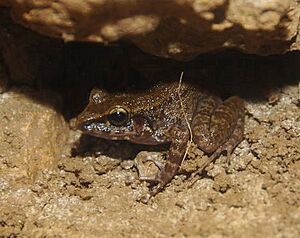Platymantis insulatus facts for kids
Quick facts for kids Platymantis insulatus |
|
|---|---|
 |
|
| Conservation status | |
| Scientific classification | |
| Synonyms | |
|
Platymantis insulata (unjustified emendation) |
The Platymantis insulatus is a special kind of frog. It belongs to the family Ceratobatrachidae. This frog lives only on the Gigante Islands in the Philippines. These islands are just northeast of Panay.
People call this frog by many names. Some names are the Gigantes wrinkled ground frog or the island forest frog. It is also known as the Gigantes forest frog or Gigantes limestone frog. This frog was first found on South Gigante Island. Now, we know it lives on at least three other islands too.
What Does This Frog Look Like?
Adult male frogs are about 38 to 42 millimeters (about 1.5 to 1.7 inches) long. Adult female frogs are a bit bigger. They measure about 40 to 46 millimeters (about 1.6 to 1.8 inches) long. This measurement is from their snout (nose) to their vent (bottom).
This frog looks quite slender. Its head is narrow, and its snout is rounded and pointed. It has a large eardrum, called a tympanum. There is also a fold of skin above its eardrum.
The frog's fingers are long and narrow. They have small pads, or discs, at the end. But there is no webbing between its fingers. Its toes are also slender. They have a little webbing at the base and discs at the tips.
When these frogs are preserved, their skin looks grayish-olive green to brownish. Lighter frogs often have dark, irregular blotches. Their back legs have narrow, dark stripes across them.
Where Does This Frog Live?
The Platymantis insulatus frog lives in limestone karst forests. It also lives in caves in low-lying areas. These areas are less than 600 meters (about 2,000 feet) above sea level.
These frogs are often found in the coolest and wettest parts of caves. But both young and adult frogs go out into the forest. They do this to find food.
These frogs develop directly from eggs. This means they do not have a tadpole stage that swims freely. Each female frog can lay up to 48 eggs.
Protecting the Gigantes Frog
The Platymantis insulatus frog is common on all four islands where it lives. There are many of them when it rains a lot.
However, the places where these frogs live are shrinking and getting damaged. People are digging for guano (bat droppings) and quarrying limestone. These activities can harm the frog's home. Scientists believe the number of these frogs is going down.
This frog does not live in any special protected areas. But people are working to improve environmental protection in the area. By late 2019, plans were being made to start a group of these frogs in captivity. This would help protect the species.


